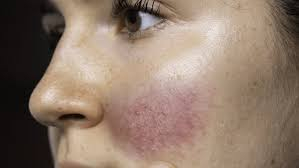Rosacea is a chronic relapsing inflammatory skin disease characterized by erythema, dilation of small and large facial vessels, formation of papules, pustules and telangiectasias. Rosacea is a fairly common disease that affects up to 10% of all dermatological patients. Recently, more and more studies are aimed at assessing systemic changes in dermatological diseases.
In this article on estet-portal.com you will learn about the relationship between rosacea and poor sleep.
- Etiological factors of rosacea
- Methods and results of research on the relationship between rosacea and poor sleep quality
- Experimental data and possible causes of the relationship between rosacea and sleep disorders
- Conclusion
Etiological factors of rosacea
The etiology of rosacea includes genetic predisposition and environmental triggers. Several single nucleotides, polymorphisms of glutathione-S-transferase (GST), 8 butyrophilin-like nucleotides BRNL2), 9 human leukocyte antigen (HLA)-DRA9 and NOD2/CARD15 have been found in patients with rosacea. GST encodes a catalytic enzyme required for reactive oxygen species (ROS).
Behavioral factors such as stress, anxiety, depression, and sleep have also been found to be associated with other inflammatory and
Several studies have reported on sleep status in rosacea. In order to study the relationship between rosacea and sleep, a study was conducted in which 608 patients with rosacea and 608 healthy controls of the same gender and age took part. Sleep quality was assessed using the Pittsburgh Sleep Quality Index (PSQI) questionnaire.

A total of 608 patients diagnosed with rosacea were examined, 85% of the study group were women. A total of 608 healthy controls were matched for sex and age. With regard to the severity of rosacea, 7.2%, 39.5% and 53.3% of them represented mild, moderate and severe rosacea, respectively.
Sleep quality has been found to be related to rosacea and to the severity of rosacea.
Rosacea patients scored higher on the global PSQI (Pittsburgh Sleep Quality Score) than controls (rosacea versus controls, 6.20 vs 3.95), with higher scores on the six PSQI components, including subjective quality sleep, sleep duration, habitual sleep efficiency, sleep disturbances and daytime dysfunction.
The proportion of patients with rosacea who had poor sleep quality was much higher than in the control group (rosacea versus controls, 52.3% vs 24.0%).
In addition, to assess the relationship between sleep factors and rosacea severity, patients with mild, moderate, and severe rosacea were compared. Patients with severe rosacea showed slightly higher overall PSQI scores (severe versus mild to moderate, 6.51 versus 5.83), with higher scores on the three PSQI components including subjective sleep quality,sleep disturbances and daytime dysfunction.
Experimental data and possible causes of the relationship between rosacea and sleep disorders

AARS guidelines for the treatment of rosacea.
To confirm the potential effect of poor sleep quality in rosacea, an SD- and LL-37-induced rosacea-like mouse model was used. Injection of LL-37 peptide resulted in a rosacea-like erythema that worsened with sleep deprivation.
Subsequently, expression of matrix metallopeptidase (MMP-9), Toll-like receptor (TLR2), cathelicidin antimicrobial peptide (CAMP) and vascular endothelial growth factor (VEGF) was found, the levels of which are increased in rosacea. These factors were activated by LL peptide -37, which
in turn increases with lack of sleep.
Conclusion Single nucleotide polymorphisms found in the hydroxytryptamine receptor 2A and adrenoceptor-b1 genes that are associated with sleep behavior and found to be associated with rosacea. In addition, models of LL-37-induced rosacea-like phenotype and sleep-deprived mice were applied, which showed that sleep deprivation exacerbates the rosacea-like phenotype in mice with higher expression of matrix metallopeptidase 9, a Toll-like receptor. 2, cathelicidin antimicrobial peptide and vascular endothelial growth factor. In conclusion, patients with rosacea had a lower quality of sleep as well as a higher likelihood of a genetic background with sleep disturbance. In addition, poor sleep may exacerbate rosacea by regulating inflammatory factors, contributing to a vicious cycle in disease progression.
Watch us on YouTube.







Add a comment